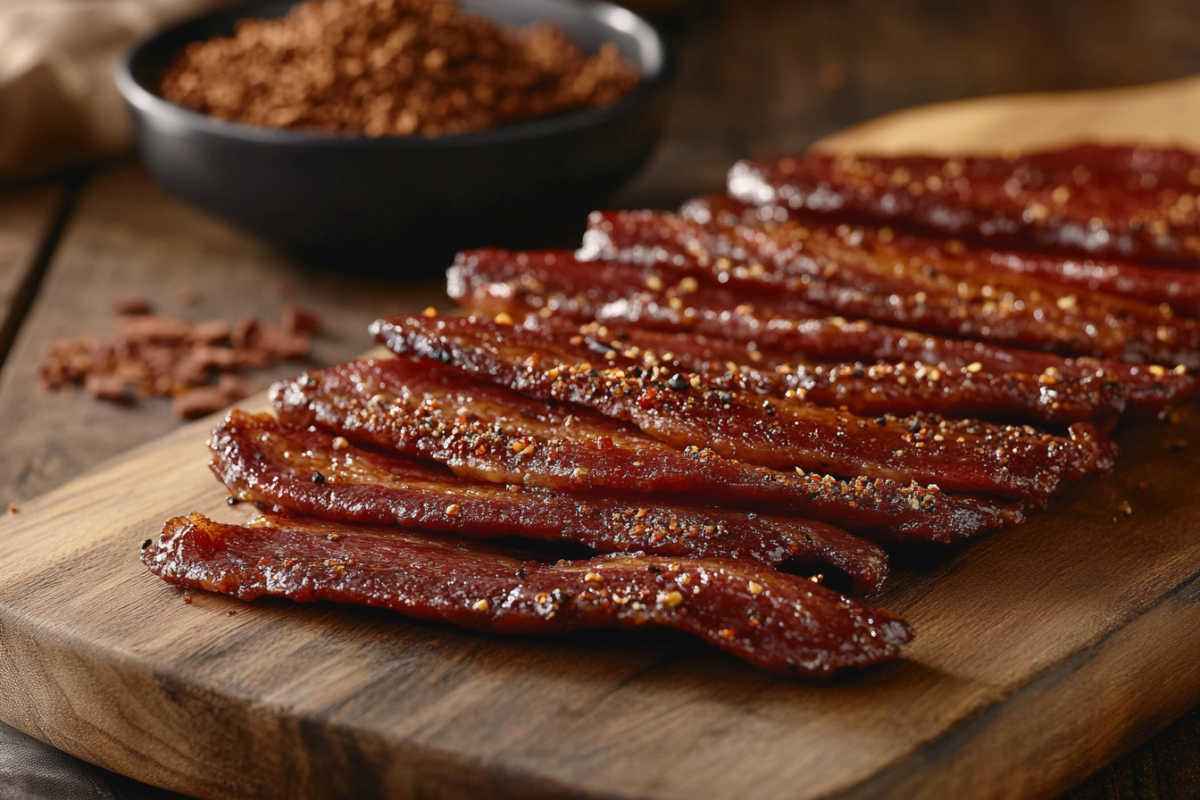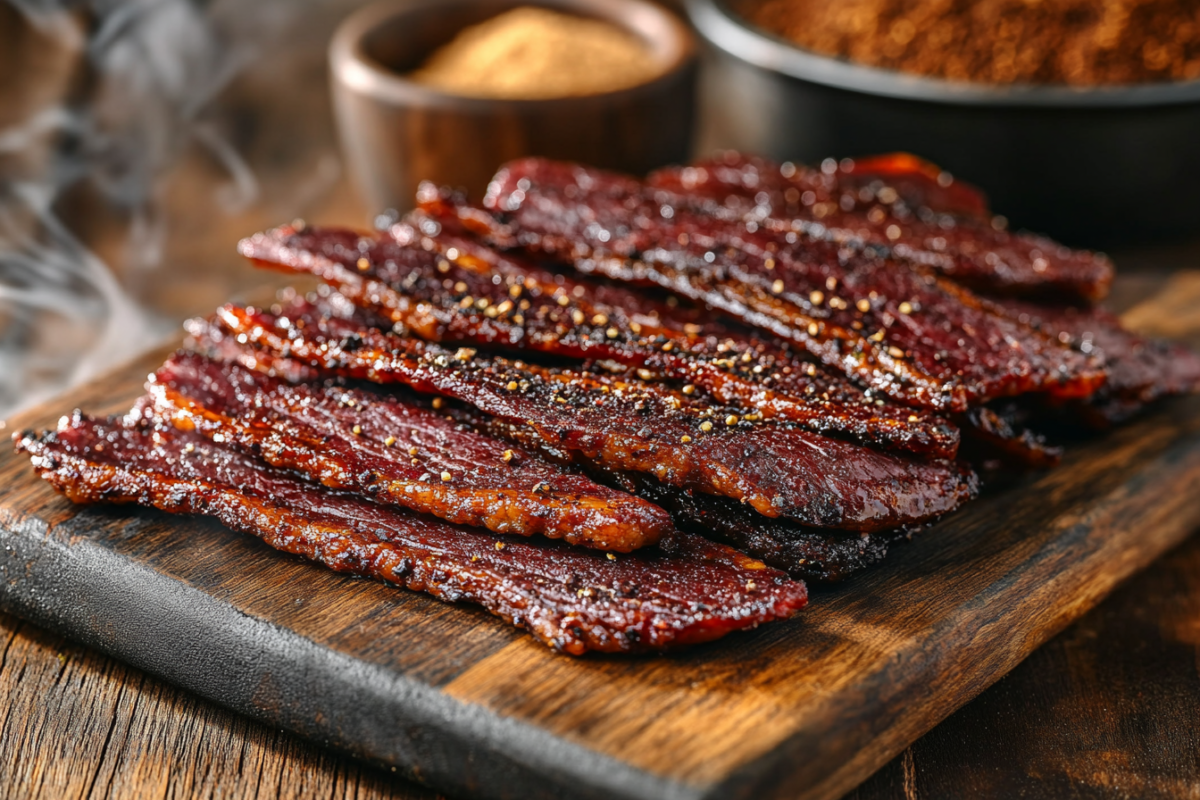In recent years, beef bacon has been gaining popularity as a delicious alternative to traditional bacon, and for good reason! Whether you’re avoiding pork for dietary reasons or simply looking to try something new, beef bacon offers the same crispy, savory goodness that makes bacon a fan favorite. But what exactly is beef bacon? How is it made, and what can you do with it? This guide will explore everything you need to know about beef bacon, from its production and nutritional benefits to some tasty recipes you can easily prepare at home. Let’s dive into the world of beef bacon and discover why it’s become a beloved substitute in many kitchens.
What is Beef Bacon?
Definition and Overview
When we think of bacon, pork bacon usually comes to mind. But did you know you can also make bacon from beef? Beef bacon is made from the belly of beef, or sometimes from other cuts like brisket. While it shares many characteristics with traditional bacon, such as being cured and smoked, beef bacon brings a unique flavor and texture to the table. It’s thicker and often leaner than its pork counterpart, with a rich, beefy flavor that enhances its crispy edges when cooked.
As a versatile ingredient, beef bacon can be used in numerous dishes—from breakfast classics to lunch and dinner options. Its growing popularity has made it a must-try for bacon lovers looking for new flavors or those who are avoiding pork for dietary reasons.
Comparison with Pork Bacon
If you’re used to the flavor and texture of pork bacon, you might be wondering how beef bacon compares. While both types of bacon are cured and smoked, the key difference lies in the meat’s origin. Beef bacon has a richer, meatier taste, with a somewhat chewier texture, especially if it’s cut thicker. In comparison, pork bacon tends to be thinner, crispier, and has a more delicate, slightly sweet flavor due to the fat content.
In terms of nutrition, beef bacon is often leaner than pork bacon, which makes it a good alternative for those looking to reduce their fat intake while still enjoying a bacon-like experience. But, of course, beef bacon is still high in sodium and saturated fats, so moderation is key.
Historical Context
You may be wondering how beef bacon even came about. Its roots trace back to the necessity of preserving beef before refrigeration was common. The process of curing and smoking meat was a way to preserve it for longer periods. While pork bacon eventually became the bacon of choice in many cultures, beef bacon remained a part of certain regional diets, especially in places with less access to pork. Over time, beef bacon was rediscovered as a delicious and flavorful alternative, thanks to its rich taste and the rise of dietary preferences that exclude pork.
Production and Preparation of Beef Bacon
How is Beef Bacon Made?
Selection of Beef Cuts
To make beef bacon, the process starts with selecting the right cut of beef. The most commonly used cuts are the beef belly, brisket, or round. These cuts are chosen for their balance of fat and meat, which is essential for achieving that delicious, crispy texture that makes bacon so irresistible. The beef belly is the most popular option, as it mimics the fatty cut of pork belly used in traditional bacon. However, brisket can also be a good choice, as it provides a slightly leaner option without compromising on flavor.
When selecting beef for bacon, it’s important to choose fresh, high-quality cuts with visible marbling. The marbling will help ensure a rich, flavorful end product after it’s cured and smoked.
Curing Process
The next step in making beef bacon is the curing process, which preserves the meat and infuses it with flavor. The curing typically involves rubbing the beef with a combination of salts, sugar, and nitrates. The salt helps draw out moisture from the meat, which aids in preservation, while the nitrates (or sometimes nitrites) are used to maintain the bacon’s signature pink color and prevent bacterial growth.
After the curing mixture is applied, the beef is left to rest in a cool place for several days, allowing the flavors to penetrate the meat. Depending on the recipe and personal preferences, some people add additional herbs or spices to the curing mixture, like black pepper, garlic, or paprika, to enhance the flavor profile.
Smoking Techniques
Once the beef has been cured, it’s time for the smoking process. Smoking is crucial for adding that distinctive smoked flavor that’s characteristic of bacon. Beef bacon can be smoked in several ways—using either a traditional wood smoker or a pellet smoker. Popular wood choices include hickory, apple, and cherry wood, as they provide a rich, aromatic smoke that complements the beefy flavor.
The beef bacon is typically smoked for several hours at a low temperature, ensuring the meat is cooked through without becoming too dry. The slow-smoking process also helps to render the fat, giving the bacon that crispy texture when cooked. The smoking process is what sets beef bacon apart from other types of bacon, as it adds a deep, savory flavor that makes it irresistible.
Commercial Production vs. Homemade Preparation
While the process of making beef bacon at home is fun and rewarding, many people opt for commercially produced versions due to convenience. Commercially produced beef bacon often undergoes a more industrialized curing and smoking process, with added preservatives to prolong shelf life. However, homemade beef bacon allows for greater control over the ingredients and the smoking process, ensuring that it’s free from artificial additives.
When making beef bacon at home, you also have the freedom to experiment with flavors. For example, you can try different wood varieties for smoking, or even create a custom spice blend for the curing process. Ultimately, whether you go for a store-bought version or try making it yourself, beef bacon is a fantastic addition to your kitchen arsenal.
How to Make Beef Bacon at Home
Ingredients Needed
Making beef bacon at home is a fun and satisfying project, but you’ll need the right ingredients to get started. Here’s a list of essential ingredients for homemade beef bacon:
- 5 lbs beef belly, brisket, or round
- ¼ cup kosher salt
- 1 tbsp pink curing salt (optional)
- 1 tbsp brown sugar
- 1 tbsp black pepper
- 1 tbsp garlic powder
- 1 tbsp paprika (optional)
- 1 tsp crushed red pepper flakes (optional)
- Wood chips (hickory, apple, or cherry wood recommended)
Step-by-Step Guide
- Prepare the Meat: Start by trimming any excess fat from the beef, but make sure to leave a good amount of fat to help with flavor and texture. If you’re using beef belly, it should already have an ideal fat ratio.
- Cure the Beef: In a small bowl, mix together the kosher salt, pink curing salt, brown sugar, black pepper, garlic powder, paprika, and any additional spices you desire. Rub the curing mixture all over the beef, ensuring it’s well-coated. Wrap the meat in plastic wrap and refrigerate for 5-7 days. Make sure to flip the beef every 1-2 days to ensure an even cure.
- Prepare for Smoking: After the curing period, remove the beef from the fridge and rinse off the excess cure. Pat the meat dry with paper towels. If you have a smoker, preheat it to 200°F (93°C).
- Smoke the Beef: Place the beef in the smoker and let it smoke for 3-5 hours, or until the internal temperature reaches 150°F (66°C). Be sure to monitor the smoker’s temperature and add wood chips as needed to maintain a consistent smoke.
- Finish and Slice: Once the beef bacon has finished smoking, allow it to cool completely before slicing. Cut it into thin slices for a crispy texture or thicker slices for a chewier bite.
Nutritional Information and Health Considerations
Nutritional Profile
Calorie Content
When it comes to calories, the amount varies depending on the cut of beef used and how it’s prepared. On average, a 1-ounce (28g) serving contains around 100-120 calories. The calorie count may fluctuate slightly based on the fat content, as beef belly typically has more fat compared to leaner cuts like brisket or round.
While the calorie count may seem high, it’s important to remember that this product provides more than just calories—it offers a good source of essential nutrients, making it a filling addition to meals.
Macronutrients
The macronutrient breakdown is quite similar to traditional bacon, with a strong focus on protein and fat content. A 1-ounce (28g) serving typically provides:
- Protein: 7-9g, which is quite high for a small serving of meat. Protein is essential
- Fat: 8-10g, with a good portion being saturated fat. While fat contributes to the flavor and texture, it’s important to monitor intake, especially if you’re watching your fat consumption.
- Carbohydrates: Little to no carbohydrates, making it an excellent choice for low-carb diets.
Given its higher fat content, it’s a good source of energy, but it’s important to balance it with other nutrient-dense foods in your meals.
Vitamins and Minerals
In addition to macronutrients, this product provides a variety of essential micronutrients, including:
- Iron: A good source, supporting red blood cell production and preventing iron-deficiency anemia.
- Zinc: Plays a crucial role in immune function, wound healing, and cell division.
- B Vitamins: Rich in several B vitamins, including B12, which is necessary for nerve function and the production of red blood cells.
These micronutrients make it a relatively nutrient-dense food, but, like any food high in fat and salt, it should be eaten in moderation to reap the benefits without overloading your diet with excess sodium or saturated fats.
Health Benefits and Risks
Potential Benefits
One of the standout benefits is its high protein content. With each serving delivering 7-9g of protein, it’s an excellent addition to a diet that prioritizes muscle growth, repair, or weight maintenance. Additionally, it provides essential nutrients like iron, which supports healthy red blood cell production, and zinc, contributing to a strong immune system. For those on low-carb or ketogenic diets, this product can also be a great protein source with minimal carbohydrates.
Another benefit is that it offers more substantial fat than traditional bacon, which can make it more satisfying in certain dishes, like hearty breakfasts or salads. While this may be a benefit for some, it also raises the need for moderation, as high-fat foods can lead to increased calorie intake and weight gain.
Health Concerns
Despite its appealing taste and texture, there are several health concerns related to consuming it regularly. First, it tends to be high in sodium, which is used during the curing process. Just a small serving can contain up to 300-400mg of sodium, so it’s important to keep an eye on your overall salt consumption throughout the day.
Finally, processed meats like this have been associated with an increased risk of certain health issues, including cancer. While occasional consumption may not pose significant risks, it’s best to limit processed meats in your diet overall for long-term health.
Culinary Uses and Recipes
Cooking with This Product
Flavor Profile
When it comes to flavor, it offers a robust and savory profile that’s both rich and slightly smoky. The curing and smoking processes add layers of complexity to the meat, while the natural beefiness shines through, making it a great alternative for anyone who loves the taste of bacon but seeks something a bit heartier. The texture can vary depending on the cut of beef used, but typically, it has a slightly chewier texture than traditional bacon, especially if it’s made from leaner cuts like brisket or round. The crispy edges contrast nicely with its tender, juicy center, offering a delightful eating experience.
Cooking Methods
When it comes to cooking, this product can be fried, baked, or grilled, each method producing a different texture and flavor:
- Frying: This is the most popular method, resulting in crispy, golden edges and a rich, flavorful bite. It’s best to fry in a hot skillet over medium heat, flipping the slices often for even cooking.
- Baking: If you prefer a less hands-on approach, baking in the oven is an excellent choice. Lay the slices on a baking sheet and cook at 375°F (190°C) for about 15-20 minutes. This method results in more evenly cooked pieces with a crisp texture.
- Grilling: For a smoky, charred flavor, try grilling. Grill over indirect heat for about 5-8 minutes, flipping occasionally. This method enhances the meaty taste while adding an outdoor flair.
Pairing Suggestions
This product pairs well with a variety of foods. Here are some ideas to complement its hearty flavor:
- Eggs: Whether scrambled, fried, or poached, eggs are a classic pairing, making for a delicious breakfast.
- Salads: Add crispy pieces to a fresh salad for an added crunch and depth of flavor. It works particularly well with Caesar salads or arugula-based greens.
- Sandwiches and Wraps: Add slices to sandwiches or wraps for extra flavor and texture. Pair it with fresh vegetables, cheese, and condiments for a satisfying meal.
- Pasta: This product adds meaty richness to pasta dishes, especially in creamy sauces or carbonara-style recipes.
Popular Recipes
Breakfast Sandwich
Ingredients:
- 2 slices of this product
- 1 egg, fried or scrambled
- 2 slices of whole grain bread or a toasted English muffin
- 1 slice of cheddar cheese
- Fresh spinach or arugula
- Tomato slices
- Salt and pepper to taste
Preparation:
- Cook the product by frying in a skillet over medium heat until crispy.
- In the same pan, fry or scramble the egg to your preference.
- Toast the bread or muffin and layer with the cheese slice.
- Add the cooked product, egg, and fresh vegetables.
- Season with salt and pepper, and assemble the sandwich.
Beef-Wrapped Jalapeño Poppers
Ingredients:
- 6 fresh jalapeños
- 12 slices of this product
- 4 oz cream cheese, softened
- ½ cup shredded cheddar cheese
- 1 tbsp garlic powder
- Salt and pepper to taste
Preparation:
- Preheat oven to 375°F (190°C).
- Slice jalapeños in half and remove seeds.
- Combine cream cheese, shredded cheddar, garlic powder, salt, and pepper.
- Stuff each jalapeño half with cheese mixture.
- Wrap each stuffed jalapeño with a slice and secure with toothpicks.
- Bake for 20-25 minutes, until the bacon is crispy and cheese is melted.
Caesar Salad
Ingredients:
- 4 cups romaine lettuce, chopped
- 6 slices of this product, cooked and crumbled
- ¼ cup Parmesan cheese, grated
- 1 cup croutons
- ½ cup Caesar dressing
Preparation:
- Toss chopped lettuce with Caesar dressing.
- Add crumbled product, croutons, and Parmesan.
- Toss until evenly coated.
Carbonara
Ingredients:
- 8 oz spaghetti or other pasta
- 4 slices of this product, chopped
- 2 eggs
- 1 cup Parmesan cheese, grated
- 1 tsp black pepper
- Salt to taste
Preparation:
- Cook pasta and set aside, reserving some pasta water.
- Cook the chopped ingredients in a large skillet.
- Whisk together eggs, Parmesan, black pepper, and salt.
- Add cooked pasta to skillet with product, tossing to combine.
- Remove from heat and quickly stir in egg mixture, adding pasta water to create a creamy sauce.
- Serve immediately, garnished with extra cheese and pepper.


